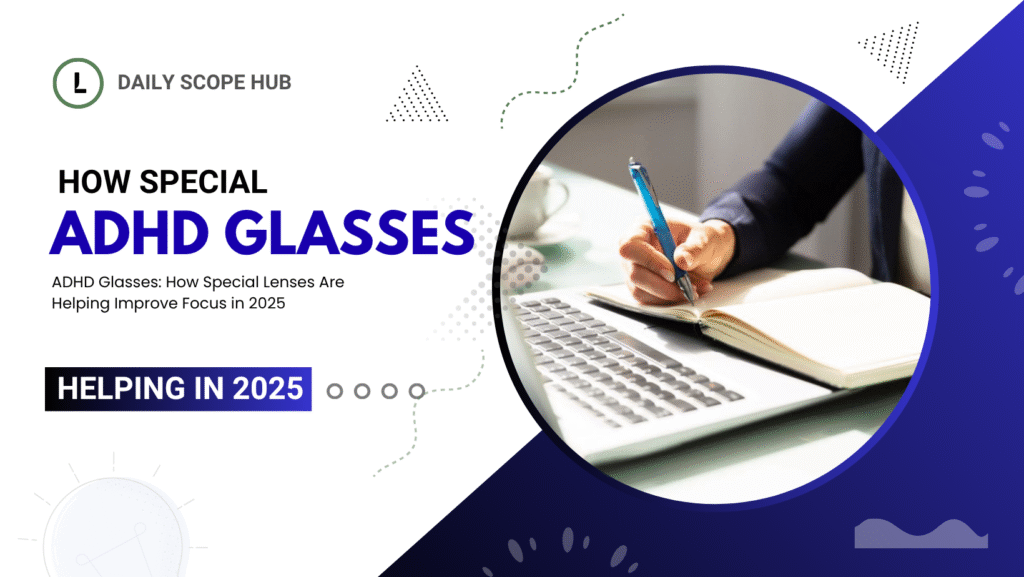ADHD Glasses: How Special Lenses Are Helping Improve Focus in 2025
Table of Contents
Introduction
Due to advancements in assistive technology, ADHD glasses are becoming popular innovative tools designed to help individuals diagnosed with Attention Deficit Hyperactivity Disorder (ADHD). These glasses assist individuals in managing their everyday challenges, primarily through enhancing focus while diminishing distractions. This article centers on several popular brands, ADHD prism glasses, neuro glasses for ADHD and the most recent Vizo ADHD glasses, and focuses on their mechanisms, advantages, and whether the benefits are substantial enough to warrant a trial.
What Are ADHD Glasses?
ADHD glasses are meant for people with ADHD who have difficulty concentrating, managing visual stimuli, and focusing in general. These glasses are not the same as regular, vision-correcting glasses. In addition to the Prism alignment and light filtering used in regular glasses, these glasses incorporate other technologies like color modulation to calm brain overstimulation.
Attention Deficit Hyperactivity Disorder glasses help to streamline the brain’s visual processing and reduce distractions when people with ADHD experience visual sensory overload. ADHD glasses reduce visual ‘noise’ so the brain can concentrate and process the image and focus on the task at hand. They are sometimes explained as ‘color blind glasses’ for people with ADHD because they adjust the way the eyes and the brain perceive color and contrast to reduce mental strain and fatigue.

How Do ADHD Glasses Work?
People often wonder, “How do ADHD glasses work?” The response involves both optics and neuroscience. The glasses’ lenses are designed to block certain wavelengths of light, which could cause excessive stimulation to the attention focus and systems. For example, screens that emit blue and white light can induce distraction and restlessness for ADHD individuals. ADHD glasses for focus help by blocking these frequencies and provide a calmer visual environment.
Other models, such as ADHD prism glasses, contain micro prisms that help light to be aligned that enters the eyes, providing better coordination of the right and left hemispheres of the brain. Vizo glasses adhd. This allows the balancing of eye shifts and concentration, which can be quite beneficial while reading, studying, and working on the computer. The other type, neuro-glasses ADHD, incorporates eye tracking and biofeedback smart technology to assist attention pattern retraining over time.
Types of ADHD Glasses in 2025
By the year 2025, there will exist many innovative designs created to meet different needs, styles, and preferences. Below, some examples of models released up to 2025:
- Prism Glasses for ADHD – Primarily intended for users suffering from the symptoms of migraines, and for those with difficulty in visual and motor tracking to movement, the prisms aligned on the outer corners of the prisms assist in the complex eye movement coordination and in visual focus tracking the movement.
- Neuro-Glasses for ADHD – These are smart glasses equipped with sensors to monitor the user’s eye movement and correlate it to the brain activity. They assist the user in the monitoring of distraction symptoms and in the training of refocusing.
- Vizo Glasses for ADHD – These popular 2025 lightweight digital glasses are designed to create soothing visual fields using light adaptive tint, soft light filtering, and other light filtering technologies.
- Wisey ADHD Glasses – These glasses are appreciated for their straightforward and functional design. Wisey ADHD glasses improve focus during work or school sessions using color modulation to contrast with the work surface background and eliminate excessive light.
- ADHD Glasses for Kids – These are tailored for younger users, and have added durability, comfort, and adjustable filters to assist children in remaining focused during class.
- ADHD Glasses for Adults – These models are specifically designed for working adults. They are equipped with blue light filters, anti-glare coatings, and a light-distraction visual environment to help with prolonged focus on work.
Every model focuses on different facets of distraction linked to ADHD, giving users the option to select pairs of glasses that best cater to their symptoms and everyday activities.

Benefits of ADHD Glasses
Corrective attention glasses do offer additional benefits apart from providing basic vision correction. Here are some documented benefits reported by users after regular utilization of corrective attention glasses.
- Improved Focus: Users primarily look to corrective attention glasses for helping users cope with distractibility for prolonged periods.
- Reduced Eye Strain: Corrective attention glasses directs eye strain by softening super bright direct light and minimizing glare. Eye strain during increased screen time is therefore more bearable..
- Enhanced Calmness: Corrective attention glasses have been reported to promote calmness and relaxation and to help users cope with sensory overstimulation of ADHD technological devices.
- Better Sleep Patterns: Corrective attention glasses that are marketed for ADHD also help users with sleep. They block blue light, especially if used during evening hours, which helps users with sleep.
- Increased Productivity: Users report improved productivity tied to improved focus gained with the aid of corrective attention glasses. This is especially notable for tasks performed in the home, school and work environments.
Users of corrective attention glasses report improved functioning that is linked to improved focus and the ability to cope with visual overwhelm.
Should You Take LDN in the Morning or at Night? (Connection Between Light and Focus)
Though not explicitly documented, some professionals associate the management methods for ADHD with the use of LDN (Low Dose Naltrexone). LDN is known for its effects on mood and attentiveness, and there is debate on whether the benefits of LDN outweigh the risks if taken in the morning or the evening. Likewise, the timing of wearing ‘glasses for ADHD’ is equally relevant. Some individuals find that wearing the glasses during the hours when they are most focused (morning study or work sessions) enhances productivity, while others prefer using the glasses in the evening, when the cognitive load tilts in the overstimulated light range, to ease peak light overstimulation.
This is closely akin to ‘optimizing your LDN routine.

ADHD Glasses for Adults vs. Kids
Although ADHD glasses for adults and children might seem the same, they help address fundamentally different challenges.
For adults, they help mitigate distractions, assist in the focus of attention for prolonged periods in meetings and complex tasks, and help manage the challenges of working long hours in front of screens. glasses for adhd people. Many social professionals find blue-light filtering smart glasses with adaptable brightness particularly helpful.
In contrast, ADHD glasses for children assist in managing distractions in the classroom, improving reading comprehension, and helping children regulate in overstimulating environments. They often come in more vibrant colors, altered for size, and made with different materials for greater sturdiness, suitable for ADHD children.
Despite the differences, both serve the same purpose of providing a visually tranquil atmosphere, allowing the brain to focus naturally, without solely relying on medication.
Do ADHD Glasses Actually Work? (What Research and Reviews Say)
It is only natural that there is skepticism concerning the newest technological advancements. Numerous individuals review personal accounts for ADHD glasses on Reddit and similar sites. Although the results and the effectiveness of the glasses tend to vary from one individual to another, the majority agree that the glasses improve concentration and lessen visual strain, particularly when other ADHD strategies are applied simultaneously.
In addition to the personal accounts that individuals relate, several nascent clinical studies suggest that light-filtering and prism technologies can alter certain brainwave patterns that are modulated and controlled to a large extent with attention and calmness. like color blind glasses but for ADHD. More focused research is anticipated as the glasses for ADHD prism and neuro-therapy become more precise in their therapeutic effectiveness.
Popular Brands and Innovations in 2025
In 2025, notable milestones in ADHD innovation were reached, primarily spearheaded by leaders such as Vizot Glasses, Wisey Glasses, Neuro-Glasses, and Color Blind Glasses for ADHD.
- Vizot Glasses ADHD are multifunctional glasses designed for contemporary lifestyles, incorporating technology, adjustable and customizable features, and light filtration for modern lifestyles.
- Wisey ADHD Glasses are targeted towards students and first-time users due to their competitive pricing and efficiency.
- Neuro-Glasses ADHD, embedded with smart Neuro-feedback technology, are the latest models integrating new technology with ADHD management.
- Color Blind Glasses were originally designed for color correction but are also used as calming and balance correction glasses by those with ADHD.
These products are redefining the interface of cognitive neuroscience with optical design and Natural Support for Cognitive Functioning.

What Makes ADHD Glasses Different from Regular Glasses?
Attention Deficit Hyperactivity Disorder (ADHD) glasses perform functions beyond simply vision correction. Neuro glasses adhd, as opposed to standard prescription glasses, which aid in vision clarity, ADHD glasses assist in cognitive functioning.
ADHD glasses assist in easing cognitive shifting, light transition, and visual task completion, and help in focusing for long sustained periods. Prism glasses adhd. They assist in shifting attention during mentally demanding tasks, which require sustained attention such as reading, studying, and coding.
ADHD Glasses Reviews: What Users Are Saying
One of the most important signs of success for a product is the feedback it receives. Within online communities, such as the “ADHD glasses” subreddit, users tell stories about how switching to prism or neuro-glasses has made them calmer, more productive, and less triggered by sensory overload.
Positive feedback is most prevalent from parents regarding the glasses for kids. They’ve reported improvements in attention during class and an overall increase in homework returns. ADHD glasses for adults have also drawn attention from users describing a reduction in digital fatigue and improvements in digital task management.
The Future of ADHD Glasses: What to Expect
Continued advancements in technology mean these glasses will increasingly become smart technology. Features such as brainwave detection, AI-focus monitoring, and adaptive tinting will give users more control over their focus settings.
Manufacturers can also incorporate feedback technologies in the glasses to track attention and suggest focus-enhancing tasks in real-time. adhd glasses Reddit. Such technology can give users active control and improvement techniques rather than passively managing symptoms.


Conclusion
With the speed of modern life and the multitude of available distractions, focus is increasingly difficult to achieve and even more so for those suffering from ADHD. Fortunately, ADHD glasses’ recent development and enhancements focus on attention improvement, sensory overload reduction, and clarity enhancement in a non-intrusive and restful vector.
Neuro-glasses ADHD, alongside prism glasses for ADHD, exemplify the newest attention and focus-enhancing psychological, technological, and scientific breakthroughs. If you need ADHD glasses for attention in 2025, you are not alone; countless students, parents, professionals, and even children look for and need focus solutions and enhancements.